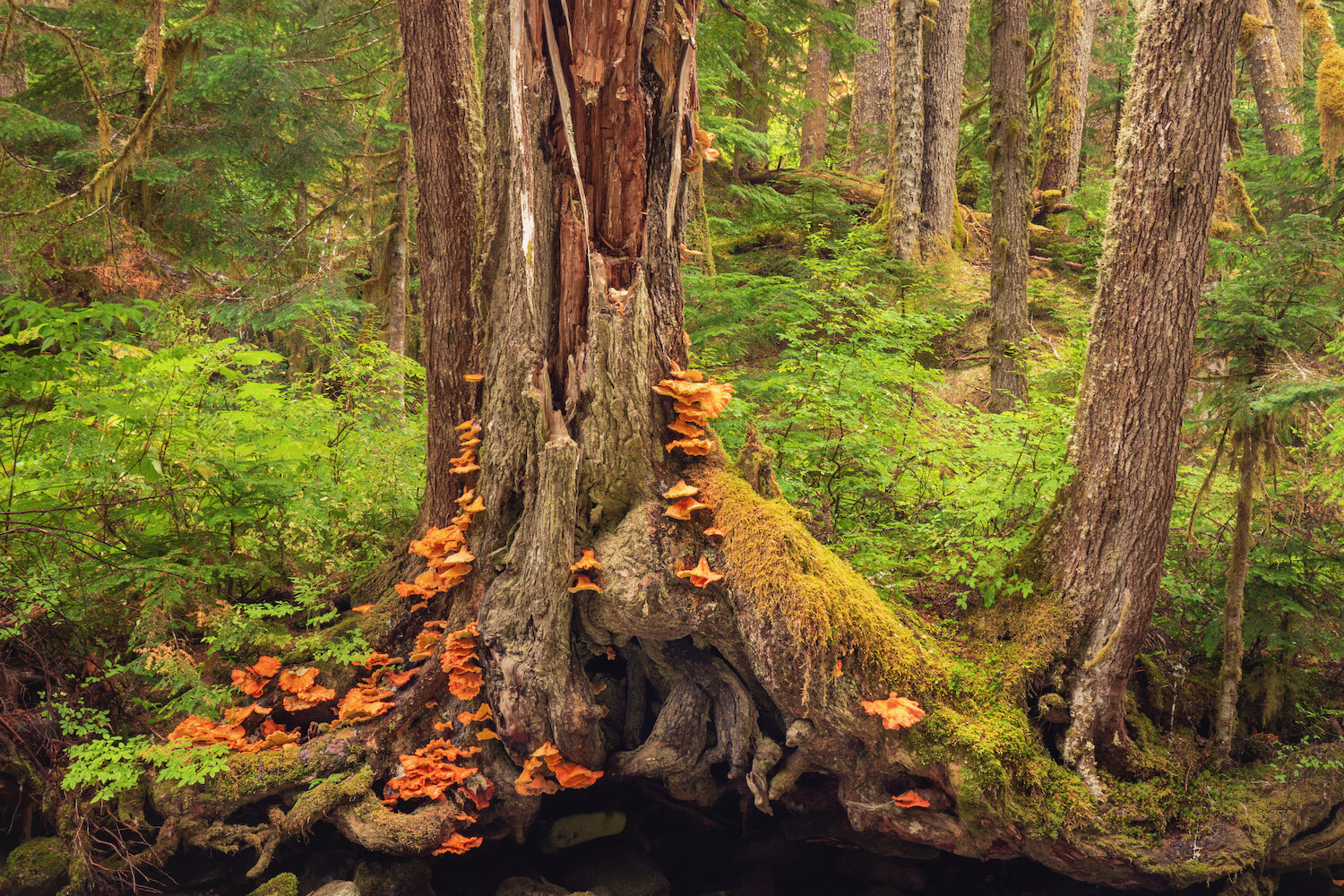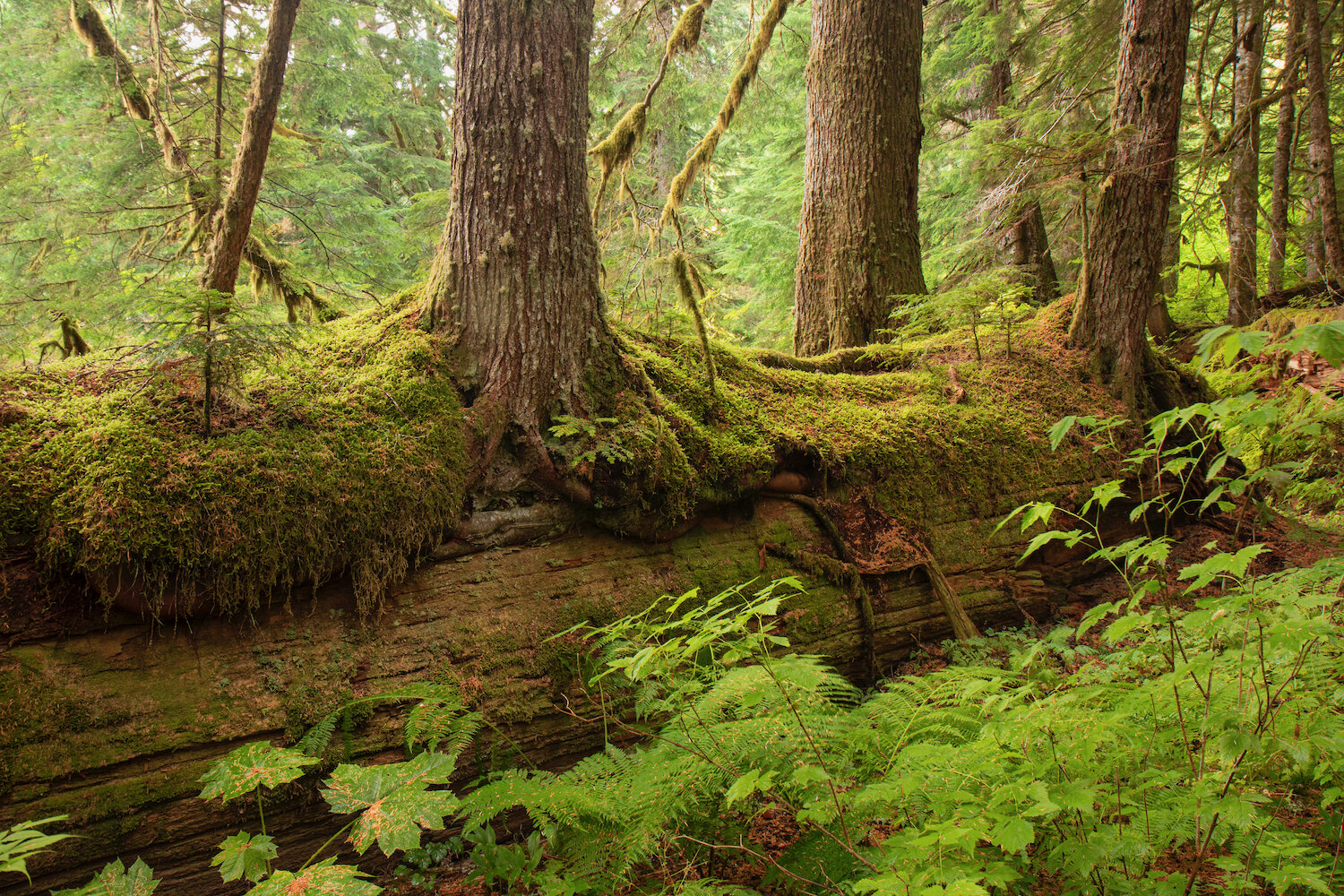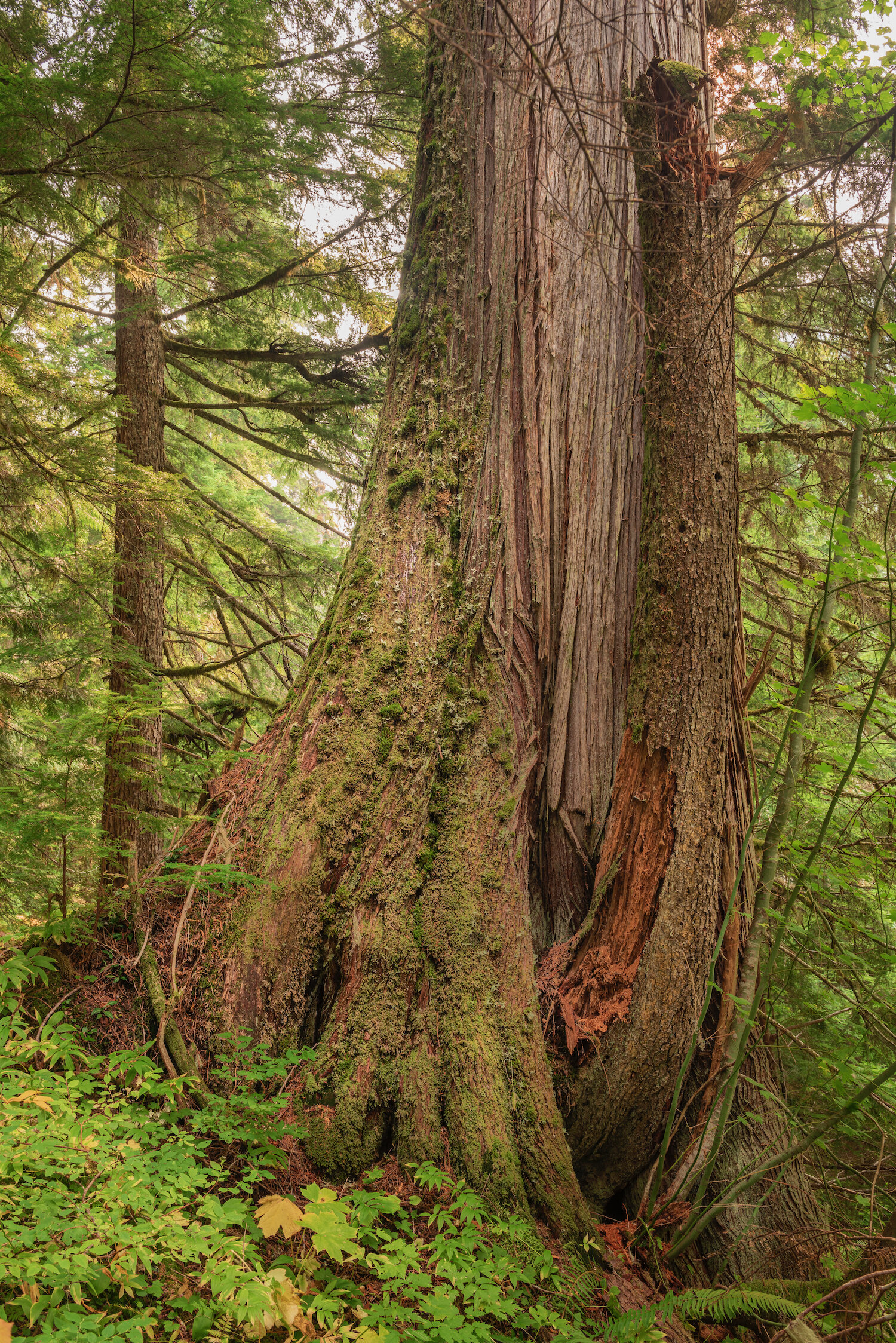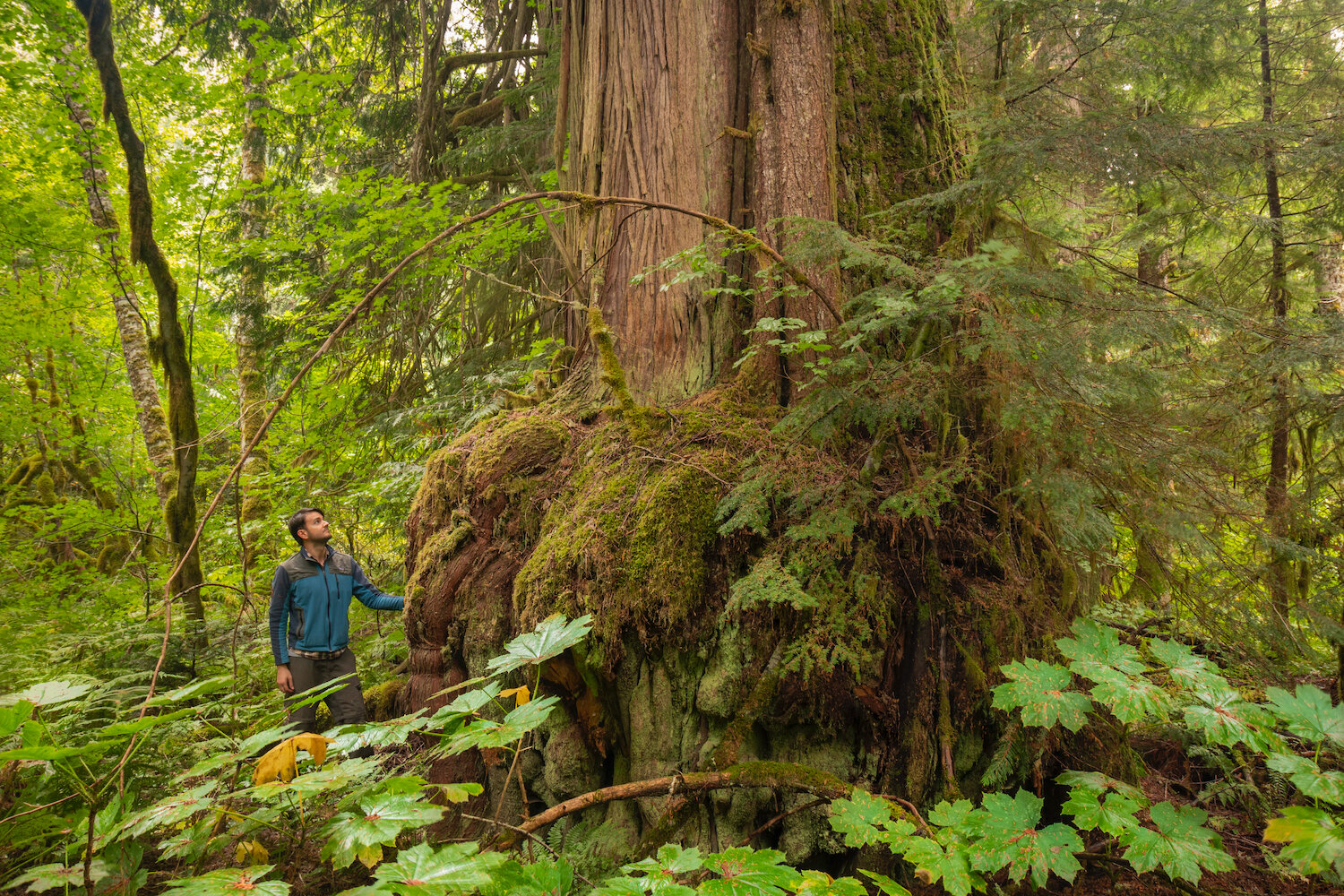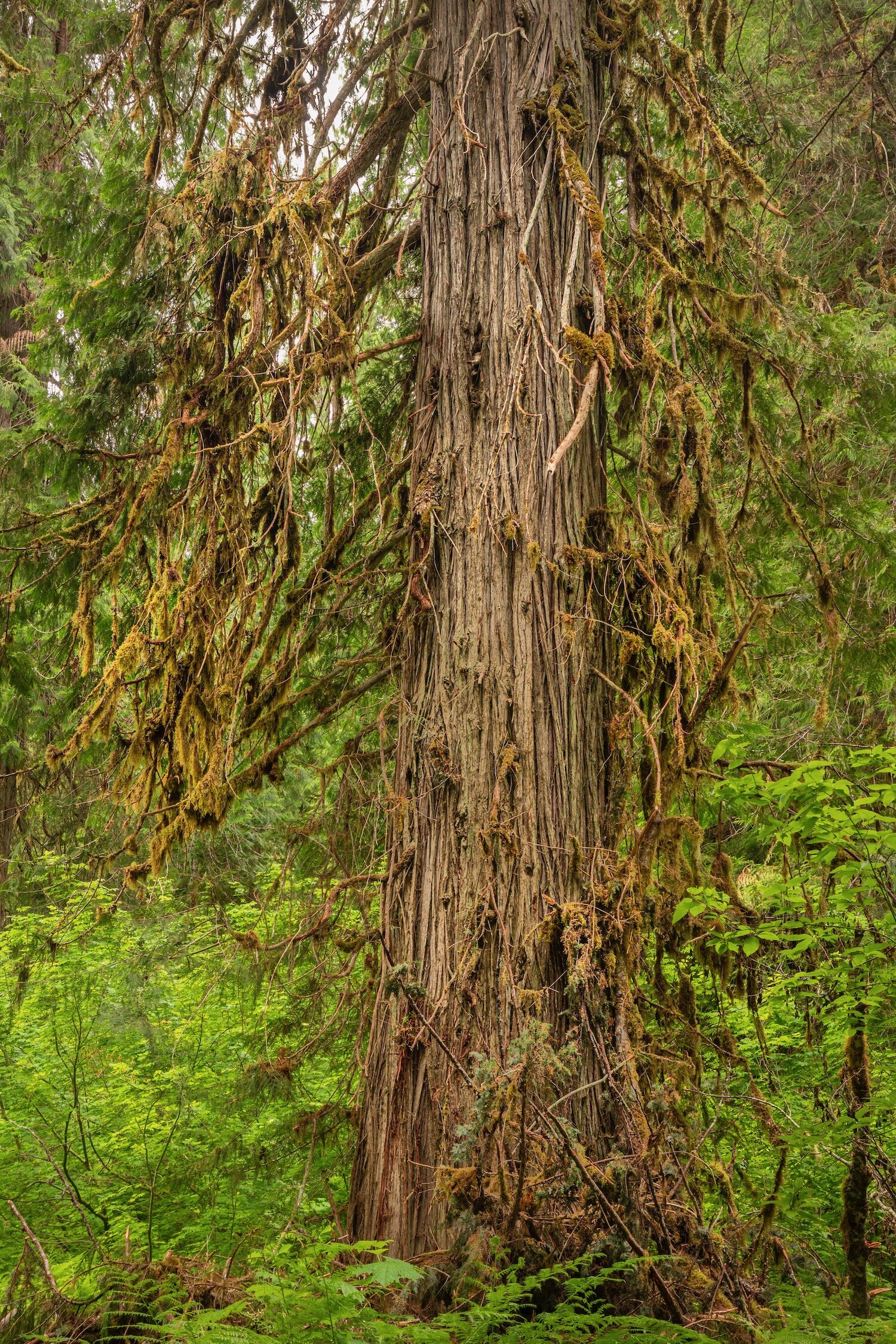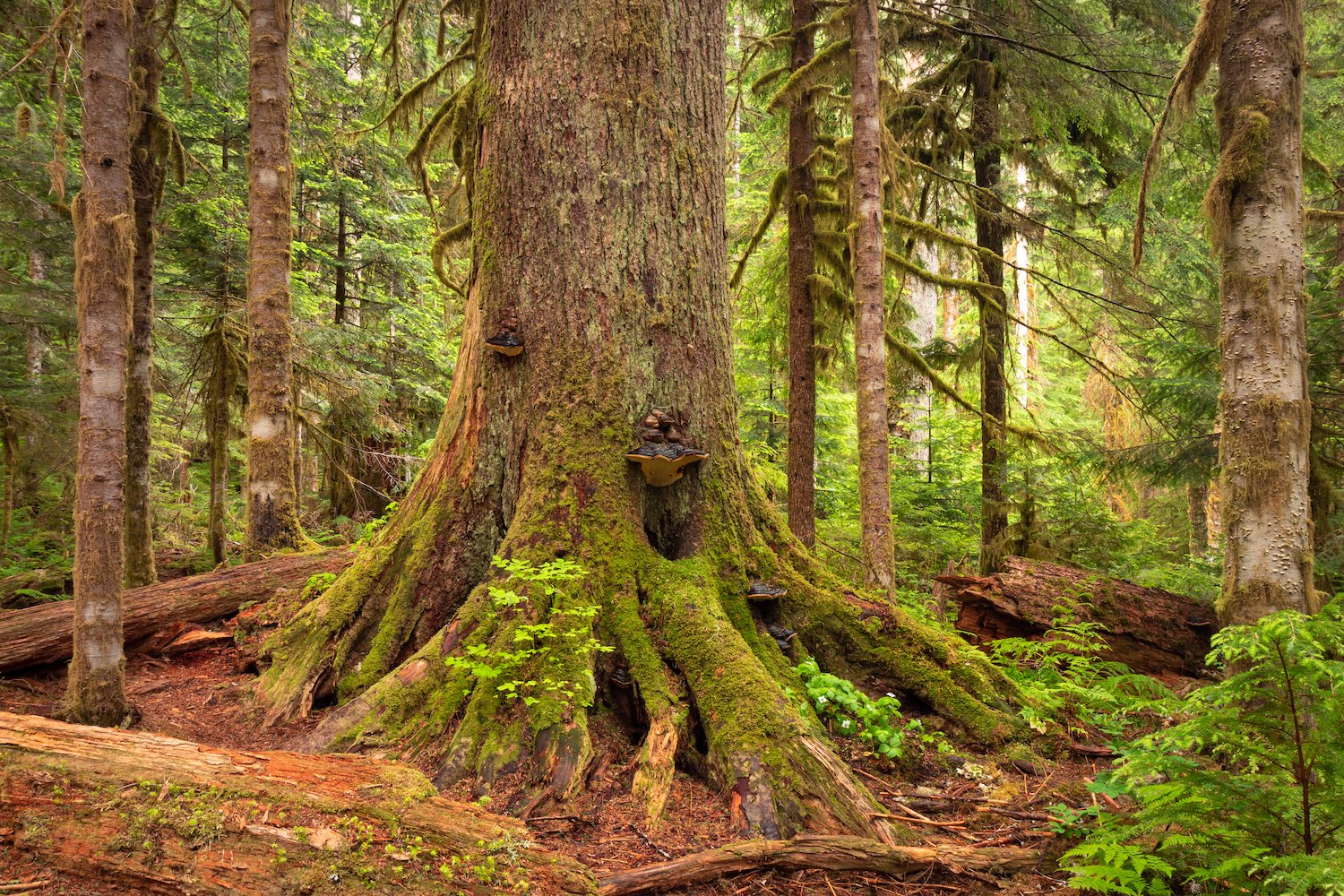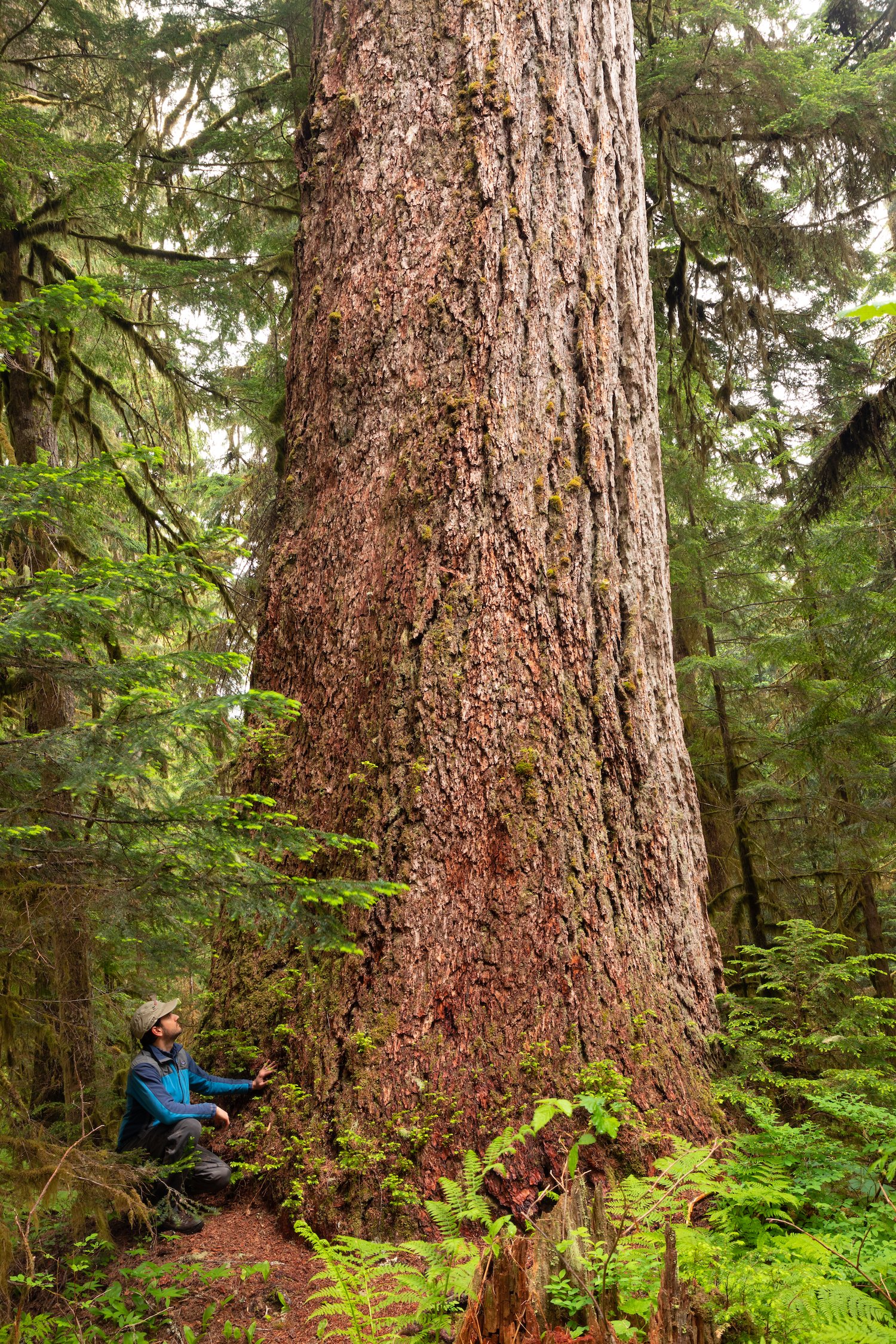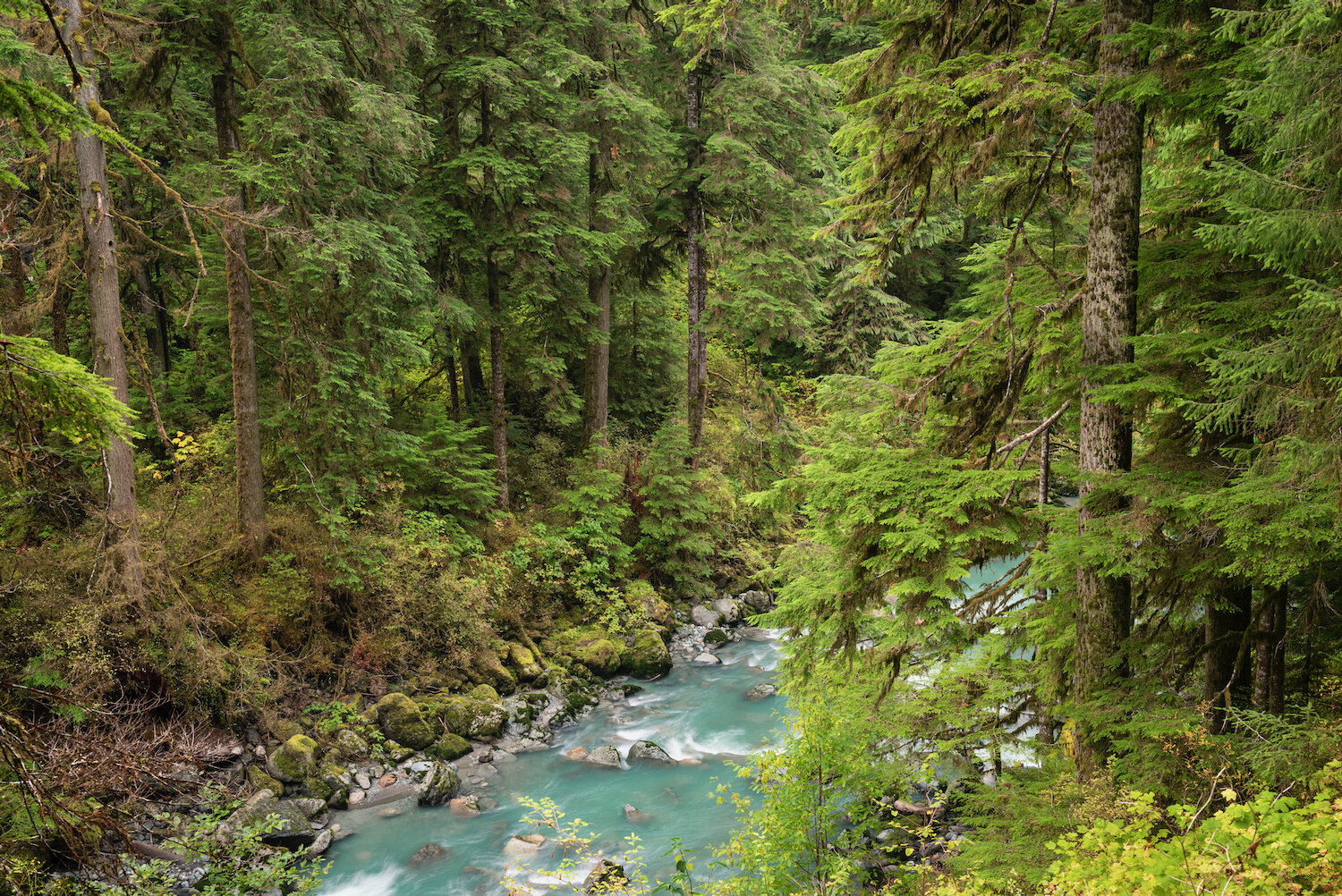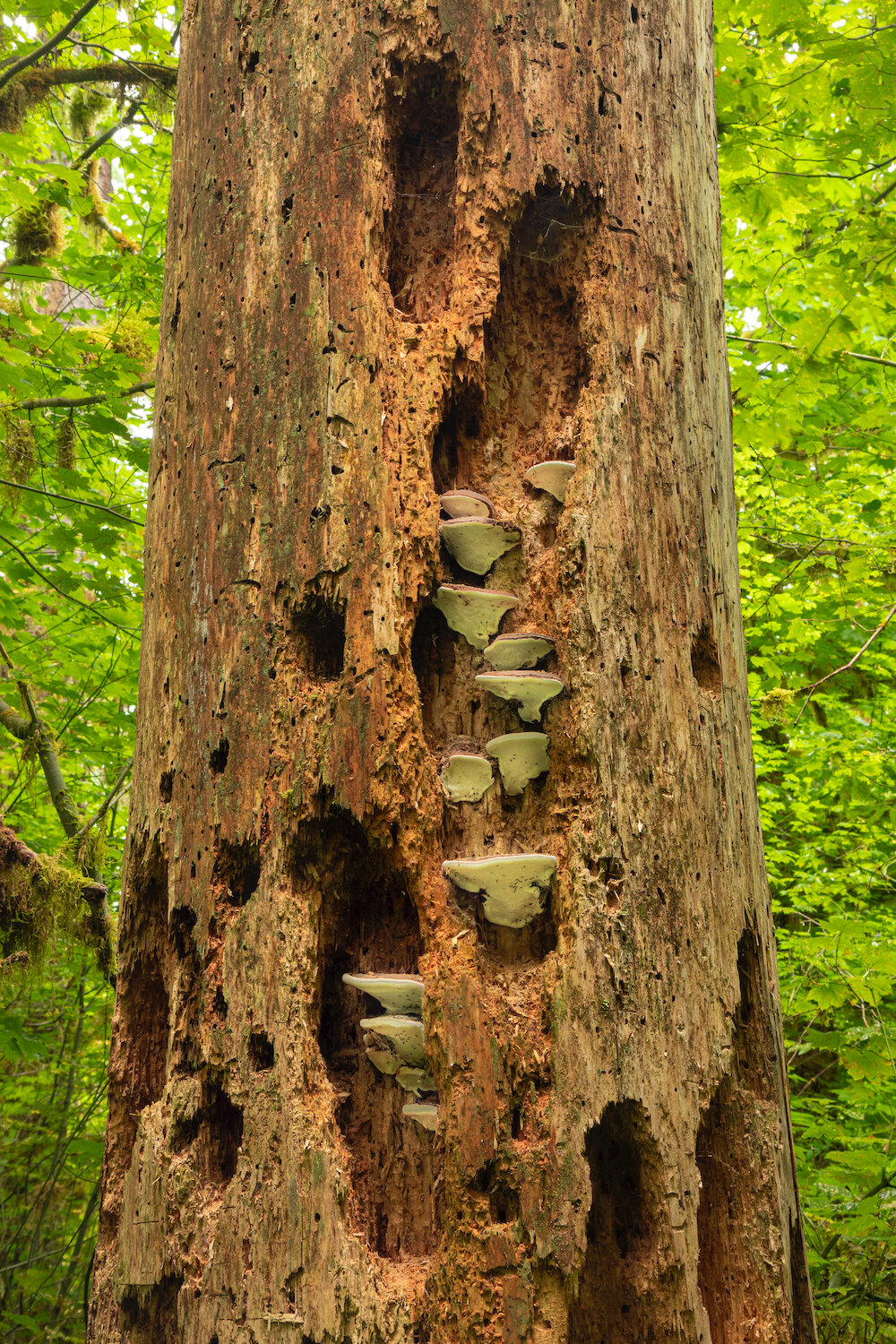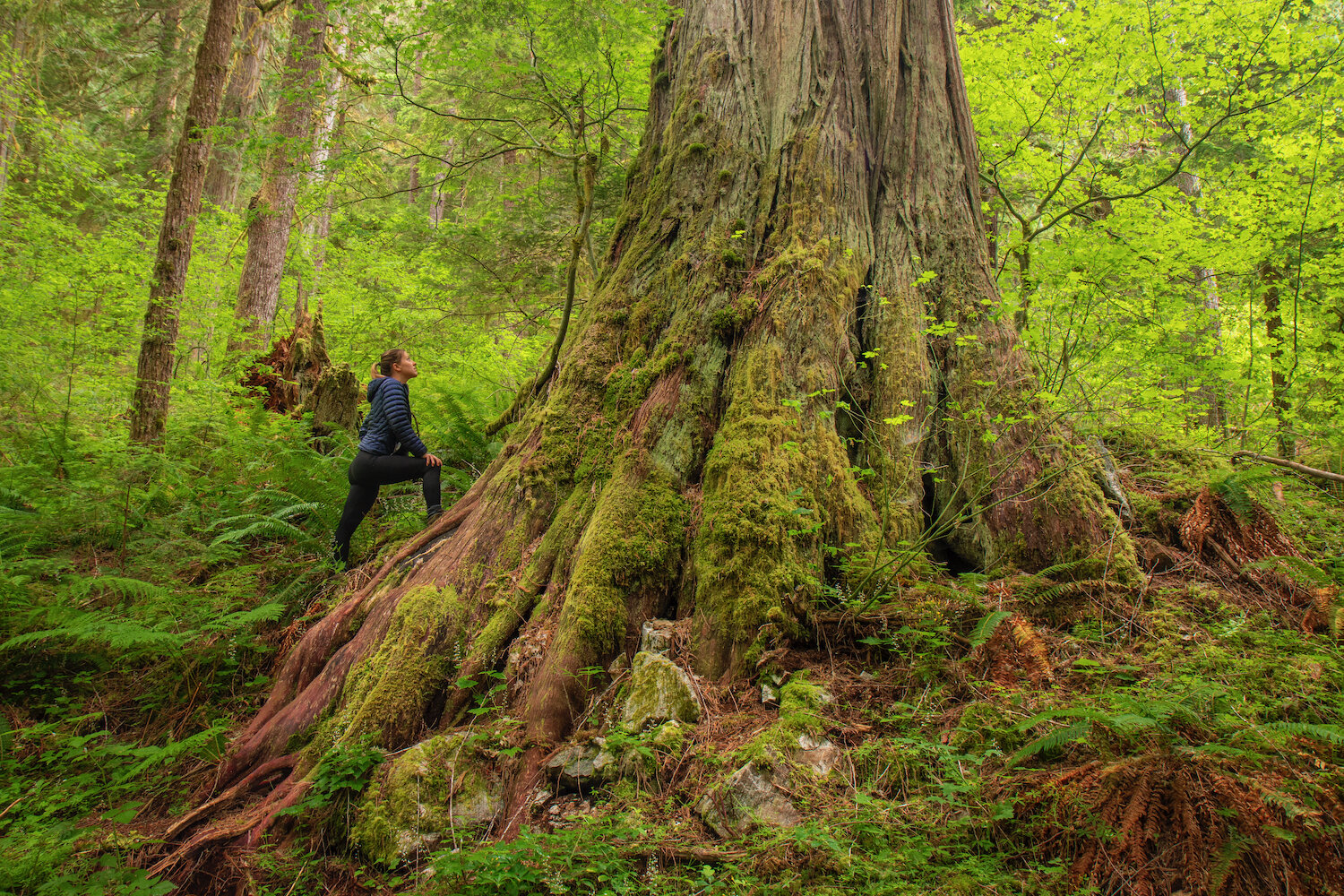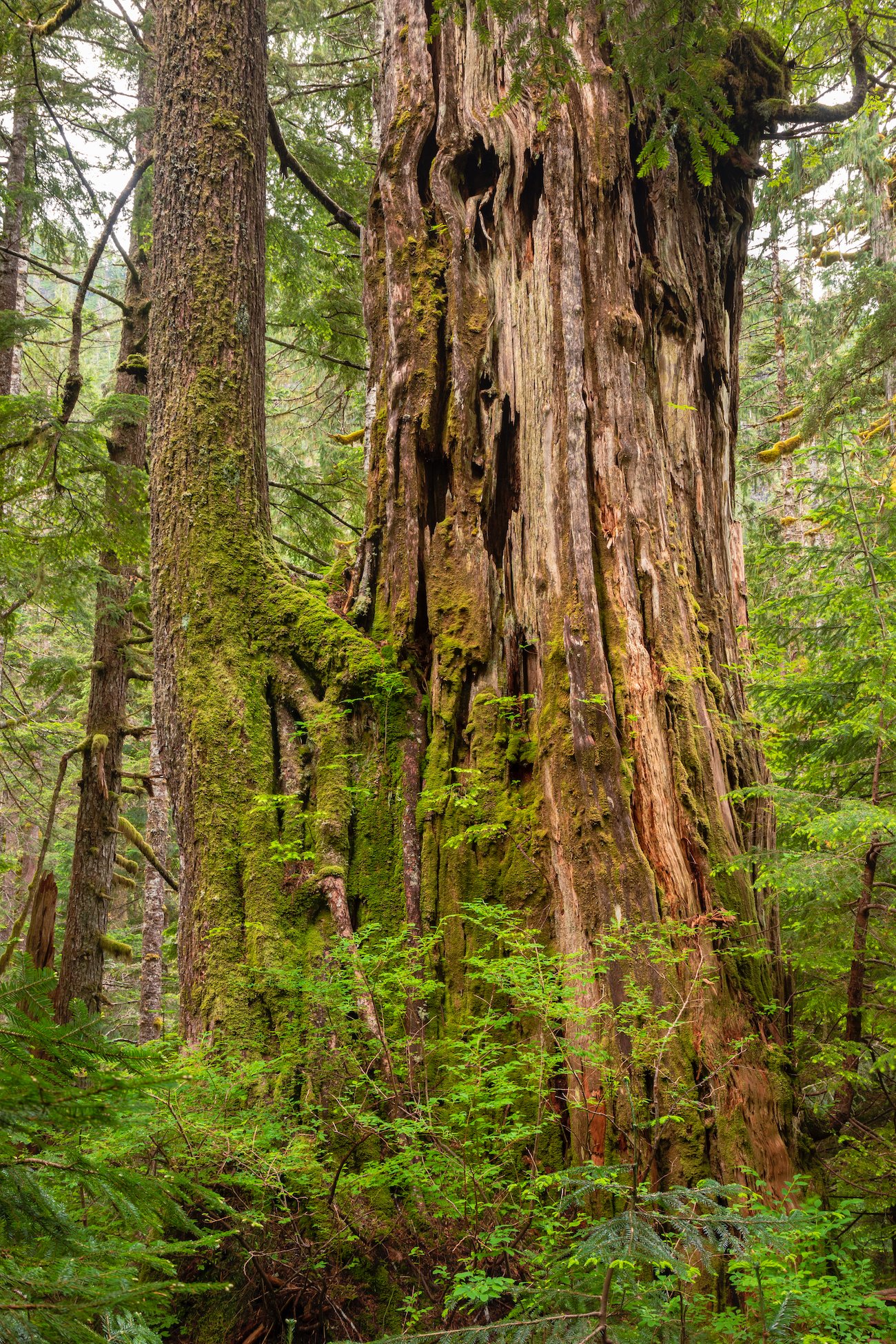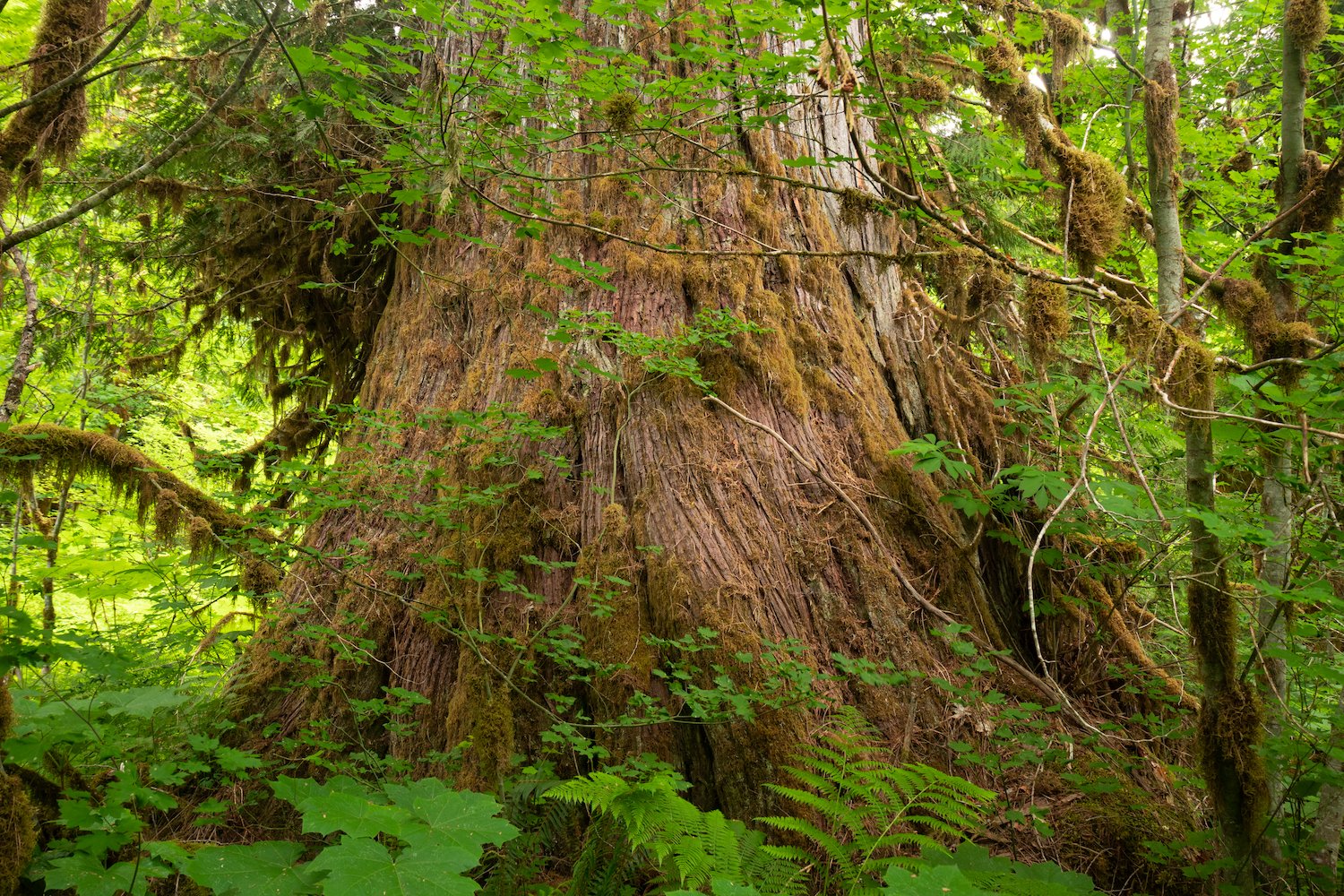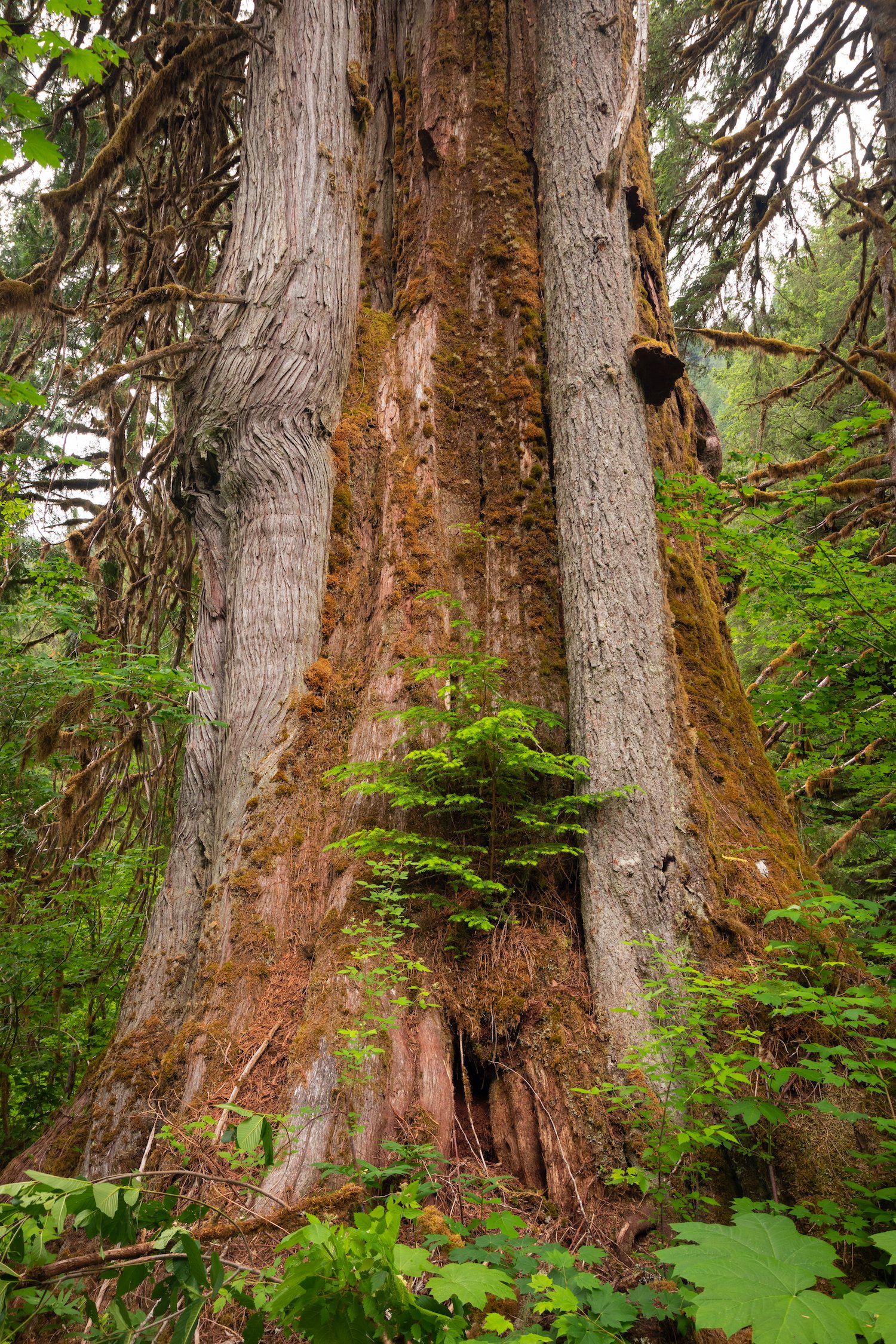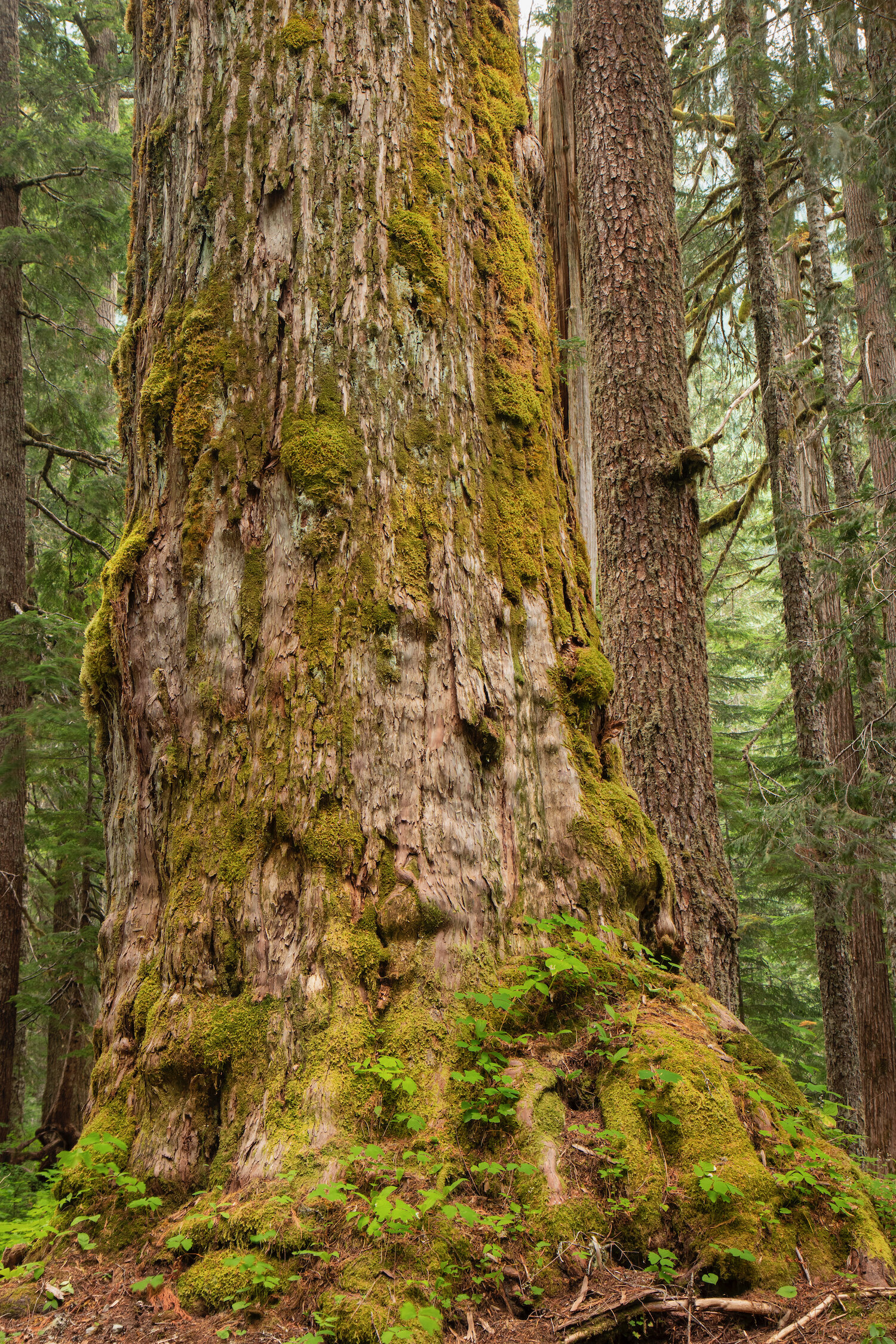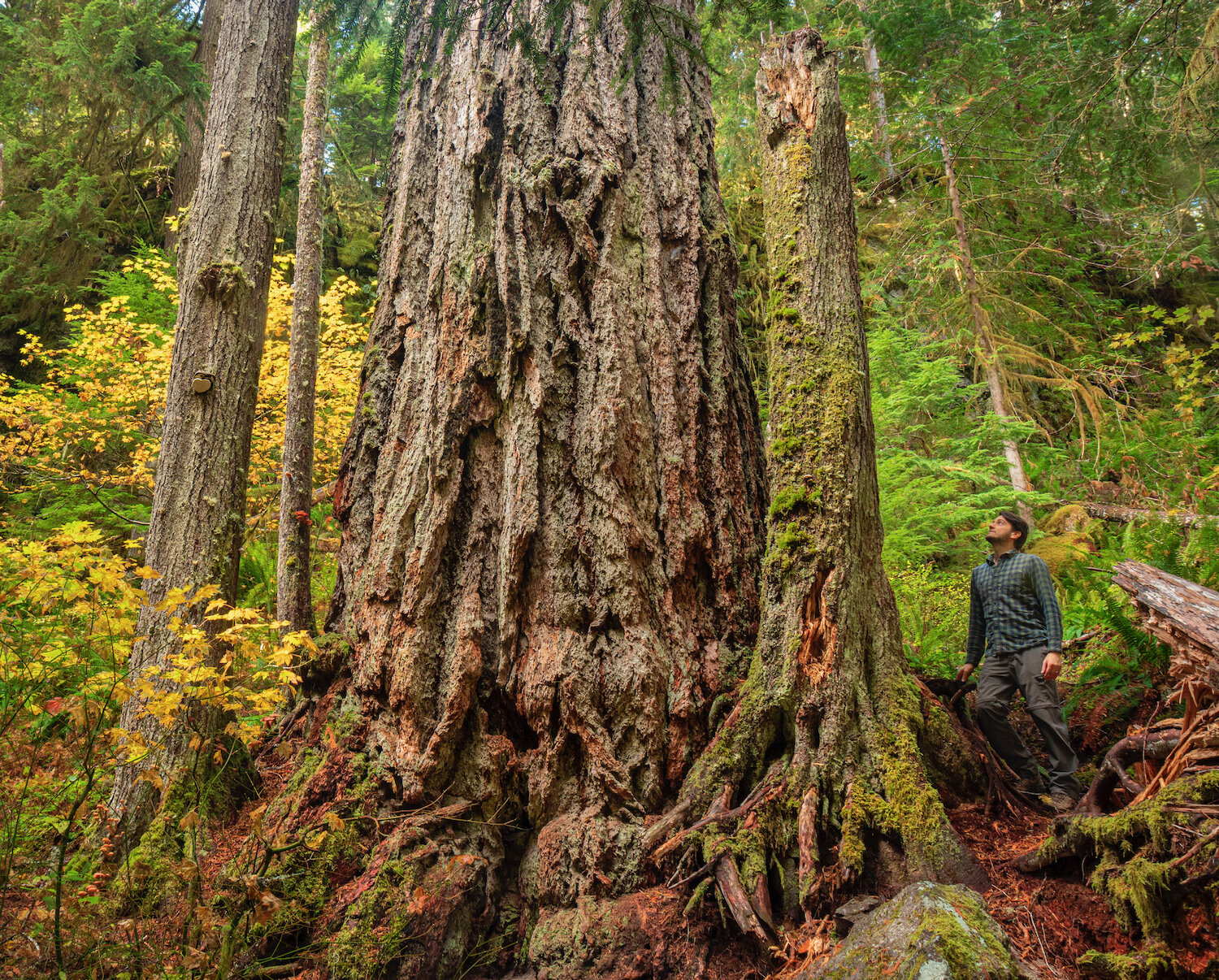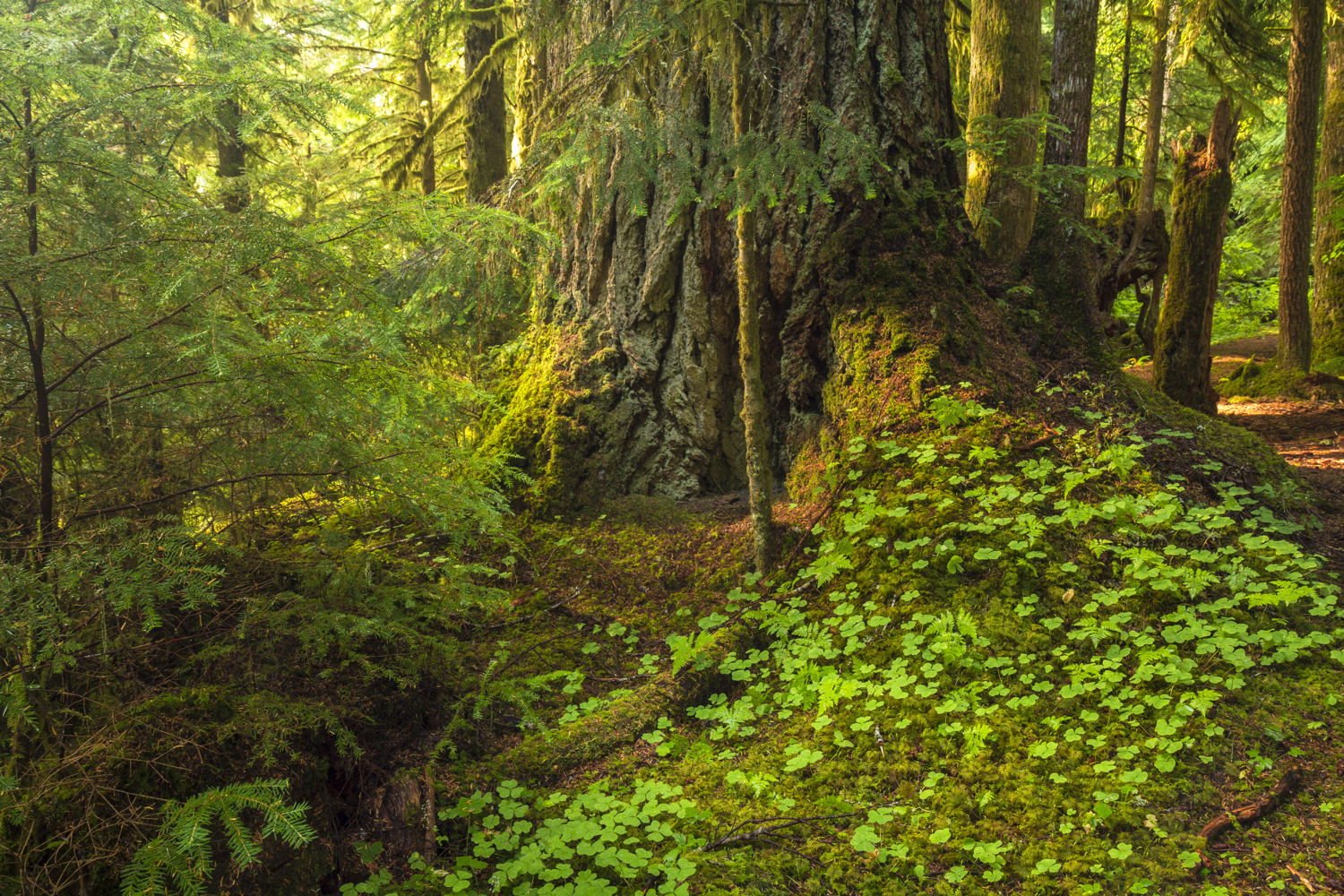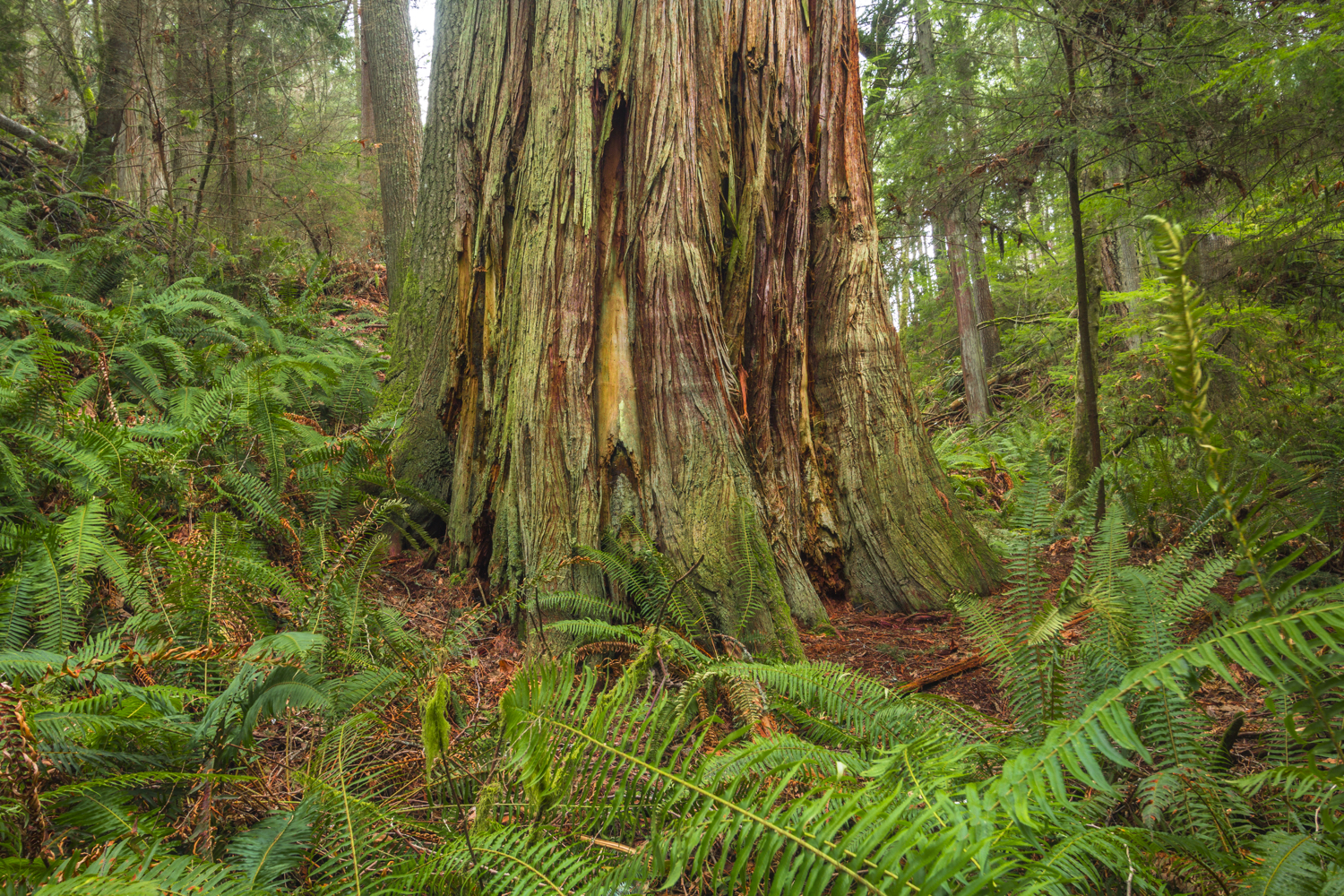north cascades & Mount Baker-Snoqualmie national forest
North Fork Sauk River
The North Fork Sauk River Trail is located in the Glacier Peak Wilderness section of Mount Baker-Snoqualmie National Forest and it passes through true Cascadian old-growth wilderness for its first 2-3 miles. Given that the area receives substantial snowfall in the winter, it’s amazing that the trees here have the time and ability to grow as big as they do. Of the many hikes profiled in this guide, the North Fork Sauk is, in my opinion, the best mile-for-mile giant tree hike in the Washington Cascades. Those first few miles are packed with enormous western red cedars, Douglas firs, and western hemlocks. These giants have been growing in this secluded valley for hundreds of years and their size is evidence of how hospitable the conditions are here.
Big tree enthusiasts can find some absolutely beautiful old-growth right on the trail. As hikers travel along the path, there is an amazing sense of being dwarfed by the majesty of this ancient forest. For those willing to engage in a bit of adventure, many massive trees of bizarre shapes are encountered off-trail as well, particularly near the banks of the river around mile three. Throughout the hike, the North Fork Sauk is always nearby, if not always visible, and provides a peaceful ambiance to the scene.
For old-growth completists, there is another nearby trail up Forest Road 4096 in the South Fork Sauk River valley by the town of Bedal. Virtually unknown, the Bedal Creek Trail follows Bedal Creek high along the hillside. The trail isn’t too populated by giant trees, but there is the occasional large example.
Bedal Creek Trail
Harold Engles Memorial Cedars Grove
Located a short drive north of the North Fork Sauk River Trail, a few titanic western red cedars—some of the largest in the Cascades—grow in the Harold Engles Memorial Cedars Grove. One of the largest trees along the primitive trail is over 14 feet in diameter, rivaling even some of the redwoods in northern California.
The entire grove is dedicated to the late Harold Engles, a Forest Service District Ranger who committed considerable effort to protecting these trees from logging and removal. His work now allows giant tree enthusiasts the opportunity to step back to a time when the forest had lain undisturbed for centuries.
Big Beaver trail
The many valleys that cut between Washington’s Cascade Range are home to forests so ancient and trees so large, they have few rivals around the world. Among the best of these is the Big Beaver River Valley and the accompanying Big Beaver Trail. For approximately 7 miles (one-way), the trail follows the north side of Beaver Creek through grove after grove of enormous western red cedar and Douglas fir. There are two approaches to the valley: a boat ride through the mountain-flanked Ross Lake or the long hike from the Ross Dam trailhead, which adds an additional six miles to the one-way hike.
The trail derives its name from the beavers that dam sections of the river to build their habitats—the same habitats that helped protect the valley from hydroelectric projects downstream. At first, it crosses Big Beaver Creek on a suspension bridge and enters a young forest. Hikers are treated to occasional views of the rushing river, marshes, and Sourdough Mountain. But the best section is found between miles three and six, where a parade of grove after grove of gigantic cedars appear. Some of these titans are nearly ten feet in diameter and grow in close proximity. One group of nearly-fused trees appears as a massive wall of wood and is a striking sight along the trail.
Fused Tree
Old-Growth Douglas Fir Grove
The best collection of gigantic Douglas firs that I’ve encountered in northern Washington is found among a couple of unmarked (and unnamed) trails in Mt. Baker-Snoqualmie National Forest, just off Highway 542. A few miles east of Glacier, WA, two surprisingly well-trodden paths lead into the forest, passing by giant trees in an ancient landscape.
The grove is positioned at the hospitable confluence of three mountainous hillsides, feeding the lower terrain with ample water flow and allowing these huge trees to grow. Each trail is no more than a few thousand feet in length, but the grove is intersected by other less developed paths that permit further exploration.
Boulder River Trail
A local favorite, the Boulder River Trail traverses one of the most scenic river canyons in Washington. It is obvious that the Boulder River has been carving this canyon for many years. Steep and lush, the canyon walls support a variety of plants, including giant trees, moss, ferns, and shrubs.
Feature Show Falls and a number of other waterfalls cascade from the canyon heights, but equally impressive are the huge spruces and firs here. These patriarchs have survived due to the enclosed and protected nature of this canyon. Some of the trees here are about 10 feet in diameter and draped in moss. And speaking of moss, a few stretches of the trail contain groves of bigleaf maple that are simply covered in green. The hike ends about 4-5 miles down the canyon, making this an ideal day hike, particularly on a rainy or overcast day.
Baker River Trail
The verdant Baker River Valley holds two of Washington’s best Cascade rainforest hikes in the perpetually saturated valleys of Mt. Baker-Snoqualmie National Forest. Lauded by big tree enthusiasts, including the great conservationist Randy Stoltmann in his Hiking the Ancient Forests of British Columbia and Washington, the twin Baker River Trail and Baker Lake Trail are easy trails with little elevation gain.
Both trails originate from the north side of Baker Lake. The River Trail moves north for nearly 3 miles, traveling through stream crossings and past open areas filled with young alder, huckleberry, and salmonberry. It hugs the western hillside above the river that feeds into the lake and showcases a few groves of large western red cedars and bigleaf maples about a mile and a half in. Towards the end, the trail passes the boundary between the National Forest and North Cascades National Park, where it terminates at a riverside camp next to Sulphide Creek.
Baker Lake trail
The Baker Lake Trail, on the other hand, crosses the Baker River on a long suspension bridge and follows the eastern bank of the lake south for its entire length. The trail is also accessed at its southern end and can be hiked north to the suspension bridge. Some of the largest trees and best old-growth are located in the northern portion, about three miles into the hike from the north. Here, hikers are treated to giant cedars, firs, and several lovely waterfalls.
The trail is well-maintained with bridges located over the largest water crossings. This hike is much more popular than the Baker River Trail, as evidenced by its much more worn path. The campground at Noisy Creek (about four miles from the suspension bridge) is a logical turnaround point, but not before hikers are encouraged to take the Noisy Creek Trail uphill about half a mile to the gargantuan Noisy Creek Fir, which is almost 13 feet in diameter and one of the largest known Douglas firs by volume.
Noisy Creek Fir
Thunder Creek Trail
Though the Thunder Creek Trail follows the river for over eight miles south into the North Cascades wilderness, the largest cedars and firs are located in the first two miles, before the trail crosses Thunder Creek to the first camp. Here, about one mile in, a grove of gigantic cedars grows in close proximity to the trail, dwarfing hikers and offering some truly ancient old-growth. The large roots of a few trees perched on the hillsides are visible, extending nearly all the way down to the trail. The path is fairly level, making the area accessible to people of all skill levels. This grove is a magnificent introduction to a backpacking trail that, if followed for miles, penetrates far into the forest.
lake 22
Just a little over an hour away from Seattle, Lake 22 is a classic giant tree hike that climbs through an ancient forest before terminating at a stunning mountain lake. Pictures of the lake are featured here. The rivers that drain from the peaks around Mount Pilchuck have carved deep valleys over the millennia, including the one to Lake 22. After about half a mile into the hike, giant western red cedars begin to flank the trail on both sides. And for the next mile, the views into the forest only get better. Later, as the trail exits the forest through switchbacks, the trees appear smaller until hikers reach the stunning lake.
Heather Lake
Heather Lake, near Lake 22, is a trail of two halves. The first part, covering the initial mile up to the aforementioned lake, passes through a second-growth logged forest. The stumps are enormous and leave hikers wondering how magical and massive these trees would be today if they had been spared.
Without any signage to indicate a transition, the path then enters the Henry M. Jackson Wilderness, where gigantic cedars grow on the hillsides. Perhaps the most photogenic section is right before the lake, where the path levels out into a gorgeous grove of big trees. For pictures of Heather Lake, click here.
Miller River
An off-trail, bushwhacking adventure awaits intrepid explorers in the valley surrounding the Miller River of Mt. Baker-Snoqualmie National Forest. Since there are no trails, this valley and its forest are infrequently explored and often disregarded by hiking guidebooks. One solitary road, Miller River Road, traverses the land and penetrates the dense rainforest, passing through an untold number of giant trees starting around three miles south of Highway 2.
The best place to begin is the Miller River Group Campground. Close to the northern boundary of the campsite is a grove of about 10 titanic western redcedars, some of which are around 10 feet in diameter. More huge trees appear on both sides of the road further south for those willing to explore.
indian creek trail & White river trail
There are two old-growth trails north of Lake Wenatchee in the Glacier Peak Wilderness area that contain scatterings of huge trees: the Indian Creek Trail and the White River Trail. Both follow the banks of the milky blue White River as it flows southward from the heights of White Mountain. The Indian Creek Trail, in particular, has two notable groves. One is located a few hundred feet from the car park and has an absolutely gigantic cedar that must be around 15 feet in diameter, and the other is located at about the two-mile mark before the trail crosses Indian Creek and starts climbing.
mount rainier national park
Grove of the patriarchs
If it’s solitude that big tree enthusiasts seek, they won’t find it at Mount Rainier National Park’s Grove of the Patriarchs. For the throngs of visitors who enter the park annually, this grove offers a sufficient taste of the Cascades’ rich forests. Plenty of signage on the route down to the water crossing identifies various species of giant trees with useful information for the uninitiated. The boardwalk trail protects tree roots and guides visitors around the small grove—even around individual trees themselves! The popularity of the trail is certainly due to the incredible sizes of the cedars and firs here. These behemoths owe their uninterrupted growth to their location on an island, where rich moisture has protected them from fire. It’s definitely worth the obligatory stopover.
The Eastside Trail (Ohanapecosh River)
More adventurous hikers will find solitude on the Eastside Trail that originates from the same trailhead leading to the Grove of the Patriarchs. This trail follows the Ohanapecosh River for approximately 10 miles northward to Cayuse Pass. Some of the largest trees are located in the first mile as well as about five miles further north, but the entire path consists of classic riparian old-growth. Several 700-year-old Douglas firs located on this trail are survivors of multiple fires and look absolutely incredible next to their younger neighbors. As an added bonus, those who travel far enough will eventually encounter the photogenic Ohanapecosh Falls and Stafford Falls right on the trail.
Cowlitz Divide Trail (Olallie Creek)
The third trail originating from the Grove of the Patriarchs area is the often-overlooked and neglected Cowlitz Divide Trail. The path steadily climbs a hill populated by massive western hemlocks, Pacific silver firs, and Douglas firs. Many of these giants are over 500 years old and have developed unique shapes and contortions over time. The hemlocks, covered in moss, are particularly primordial-looking, and some of the most interesting trees are snags that have long since died and are experiencing various stages of decay.
Carbon River Trails
The Carbon River Trails, located in the northwestern section of Mount Rainier National Park, are a series of short hikes through a unique ecosystem: an inland temperate rainforest. Carbon River Road used to run through the area, but repeated flooding prompted its permanent closure. Now, hikers and mountain bikers can walk or ride the road and observe humongous trees at a slower pace. The trails radiating from the Carbon River Road include a 3.4-mile roundtrip (9.6-mile roundtrip from the ranger station) path to Ranger Falls and Green Lake, and the 0.4-mile roundtrip (8.0-mile roundtrip from the ranger station) path to Chenuis Falls. The much shorter and kid-friendly 0.3-mile Rainforest Loop Trail begins right at the ranger station.
Green Lake Trail
Rainforest Loop Trail
Green Lake Trail
IPsut Creek trail
Connecting Mowich Lake/Tolmie Peak to the Carbon River Trails discussed above, the Ipsut Creek Trail is a leg burner: 10 miles out-and-back, with one section climbing approximately 3,000 feet in only 3.5 miles. The largest species here is Alaska yellow cedar, with a particularly notable grove around three miles into the hike (pictured below). The mature trees in this grove are hundreds of years old and have developed unique characteristics. The rest of the forest holds a diverse, smaller-sized collection of trees, and the trail never strays too far from Ipsut Creek.
Huckleberry Creek Trail
Huckleberry Creek, a beautiful river valley running north from Mount Rainier, is perfect for hikers seeking wilderness solitude. For the first mile, the trail travels through Mt. Baker-Snoqualmie National Forest and then enters the northeastern section of Mt. Rainier National Park, where the real old-growth begins. The valley isn’t stocked with a plethora of massive trees, though there are a few notable specimens. This lonely valley is better known as a wonderfully stunning example of a classic Cascadian forest.
Mount St. Helens & Gifford Pinchot National Forest
Cedar flats
Walking through the giant trees of Cedar Flats Research Natural Area evokes a unique sense of awe and majesty only achieved in the presence of old-growth. This 112-acre forest on the east side of Mount St. Helens was set aside in 1947 as a pristine example of ancient Pacific Northwest rainforest to help scientists study its complex and diverse ecosystem. The entire grove sits on a flat bench, offering a wonderful view of the Muddy River. One short loop trail circles the diverse flora of western hemlock, western redcedar, and, of course, Douglas fir.
One of the largest Douglas firs in the world, aptly named the “Cedar Flats Sentinel,” grows in this area, off-trail. Its location is known only to the few fortunate enough to have ventured successfully after it, but many enormous trees can also be found through careful scouting, including the giant cedar pictured here.
lewis river trail
An essential hike in the ancient forests of Gifford Pinchot National Forest, the Lewis River Trail is one of the best riverside hikes in Cascadia and one of the prettiest. Throughout its length, the views from the trail across the river are sublime. The vegetation encroaches right up to the water's edge in several sections. Though the trees aren’t enormous, the old-growth, moss-laden environment is still endlessly appealing. Hikers are treated to the calming sound of the water as they travel.
The trail is almost 14 miles in length, one-way. For fans of old-growth, the best portion of the trail is the first 3-4 miles, up to where the trail reaches Bolt Camp. The campground, an old lean-to built in 1931 and refurbished twice since, is a reasonable turnaround point for day-hikers. However, those who wish to continue on can access three large waterfalls farther north: Lower, Middle, and Upper Falls, profiled here.
Quartz Creek Big trees
Tucked deep in the wild Cowlitz Valley wilderness of Gifford Pinchot National Forest, the Quartz Creek Big Trees Trail exposes hikers to some of the most magnificent Douglas firs in the Cascades. These giants have been growing for more than 500 years and are exceptionally tall. Yet, as with many old-growth Douglas fir groves, the trees’ most astounding quality is their girth. Many of these specimens reach six to ten feet in width.
Because the trail is relatively unused and remote, the boardwalk section has developed a beautifully overgrown look, complete with moss and ferns flanking the path, providing a serene retreat from civilization.
Giant Trees of Lost Creek
In a hidden and undisclosed location near the southern end of Gifford Pinchot National Forest, a small grove of huge Douglas firs and western red cedars grows in a valley surrounded by mountains. The steep terrain affords the trees protection from the harshest elements and has permitted them to grow uninterrupted for hundreds of years. One particularly gnarly and stout fir, named the Russ Jolley Fir, looks as if it has anchored this forest for centuries. It, along with other trees, benefits from the nutrient-rich soil of the creek that runs through the area.
Russ Jolley Fir
Goat Marsh Lake
For fans of tree superlatives, the Goat Marsh Lake area southwest of Mount St. Helens is an important region to explore. The dominant tree here is the noble fir, and although these particular trees aren’t as massive or wide as western red cedars and Douglas firs elsewhere near the volcano, Goat Marsh contains eight of the ten largest noble firs in the world, some of which reach incredible heights. Robert van Pelt’s Forest Giants of the Pacific Coast identifies two of these towering trees, including "Riker!" and the "Goat Marsh Giant," and hints at another just shy of 300 feet tall—all found in this amazing grove. Perhaps more amazing, the firs around Goat Marsh contain the highest cubic feet per acre of biomass anywhere in the Northwest, only surpassed by coastal redwoods to the south.
Extra: Puget Sound Region
Between the towering mountains of the Cascades to the east and the coastal rainforests to the west is the great Puget Trough ecoregion—a large inland arm of the Puget Sound and home to a majority of Washington’s population. Though most of the old-growth forests here are gone, small pockets of conserved areas do exist. Giant trees can be found in places as diverse as island parks like Deception Pass State Park or lowland forests like Lewis & Clark State Park, highlighting how adaptive old-growth forests can be if left undisturbed.
Deception Pass State Park
Lewis & Clark State Park



